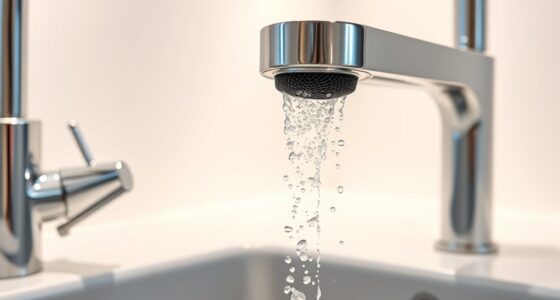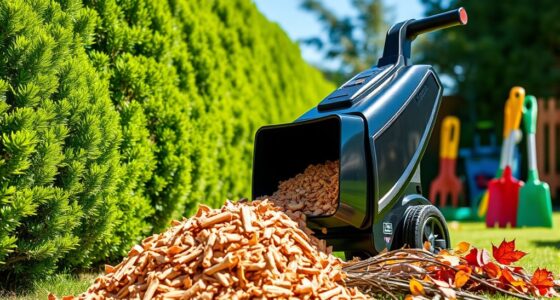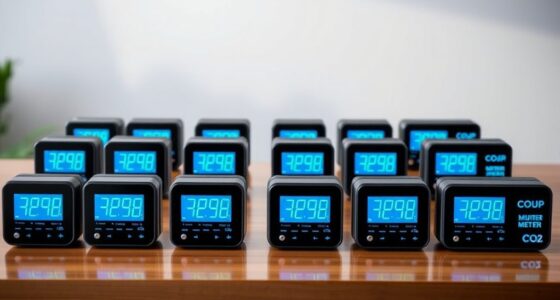If you’re looking for the best carbon-fiber filament spools for 2025, I’ve found several excellent options that deliver stronger, more durable, and high-quality prints. From reputable brands like FLASHFORGE, SainSmart, ELEGOO, Creality, VOXELAB, and SUNLU, these filaments are infused with carbon fiber to boost strength, impact resistance, and heat tolerance. Choosing the right spool depends on your specific needs and printer compatibility, but if you keep exploring, you’ll discover tips to optimize your results.
Key Takeaways
- The best carbon-fiber filaments in 2025 offer high strength, impact resistance, and heat tolerance for demanding applications.
- Compatibility with high-temp hotends and hardened nozzles is essential for optimal printing and durability.
- They produce matte or textured finishes that conceal layer lines and enhance aesthetic appeal.
- Proper handling, drying, and safety precautions are crucial due to the abrasive fibers and dust risks.
- These filaments support high-speed, precise, and lightweight prints suitable for aerospace, automotive, and industrial uses.
FLASHFORGE Carbon Fiber PETG Filament, 1.75mm, 1KG Spool
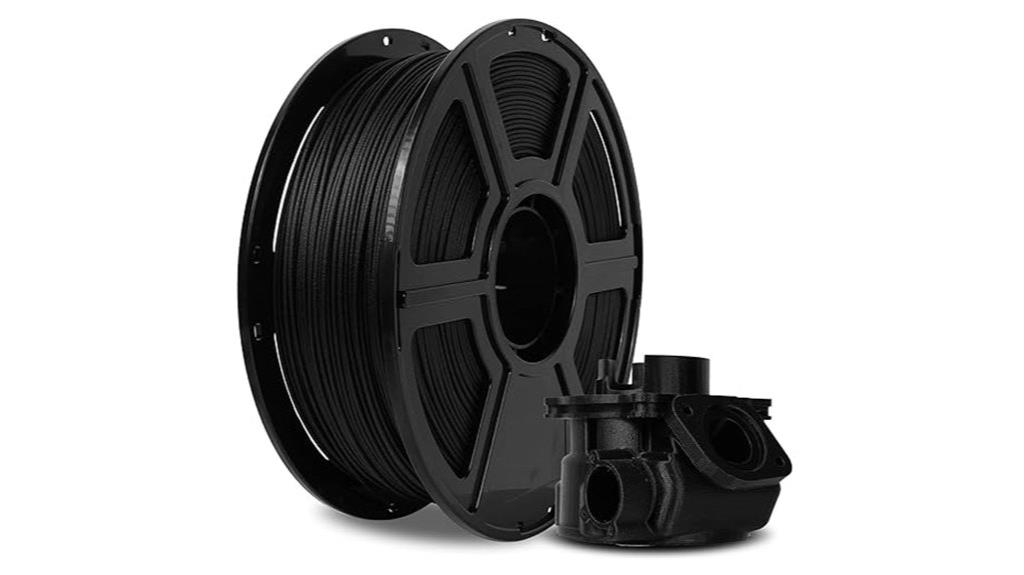
If you’re looking for a high-performance carbon fiber PETG filament that delivers both strength and stunning surface finish, FLASHFORGE’s 1.75mm, 1KG spool stands out. Its carbon fiber reinforcement boosts strength, impact resistance, and heat tolerance while maintaining PETG’s flexibility. The filament offers superb dimensional accuracy of +/- 0.02mm and a smooth, glossy surface with minimal stringing or warping. Compatible with most FDM printers, it performs well at high speeds and produces detailed, professional-quality prints. Users praise its durability, vibrant colors, and consistent quality, making it ideal for functional prototypes, industrial parts, and artistic projects.
Best For: hobbyists and professionals seeking high-strength, visually striking carbon fiber PETG filament for durable, detailed 3D printed parts and prototypes.
Pros:
- Excellent dimensional stability and surface finish with a glossy, mold-like appearance
- High strength, impact resistance, and heat tolerance suitable for functional and industrial applications
- Compatible with most FDM 3D printers, performs well at high speeds, with minimal warping or stringing
Cons:
- Slightly higher cost compared to standard PETG filaments, though justified by quality
- Requires proper print settings to minimize stringing; not entirely foolproof for beginners
- Slightly more abrasive to nozzles due to carbon fiber reinforcement, necessitating occasional nozzle maintenance
SainSmart 1.75mm Carbon Fiber Filled Nylon Filament for 3D Printing
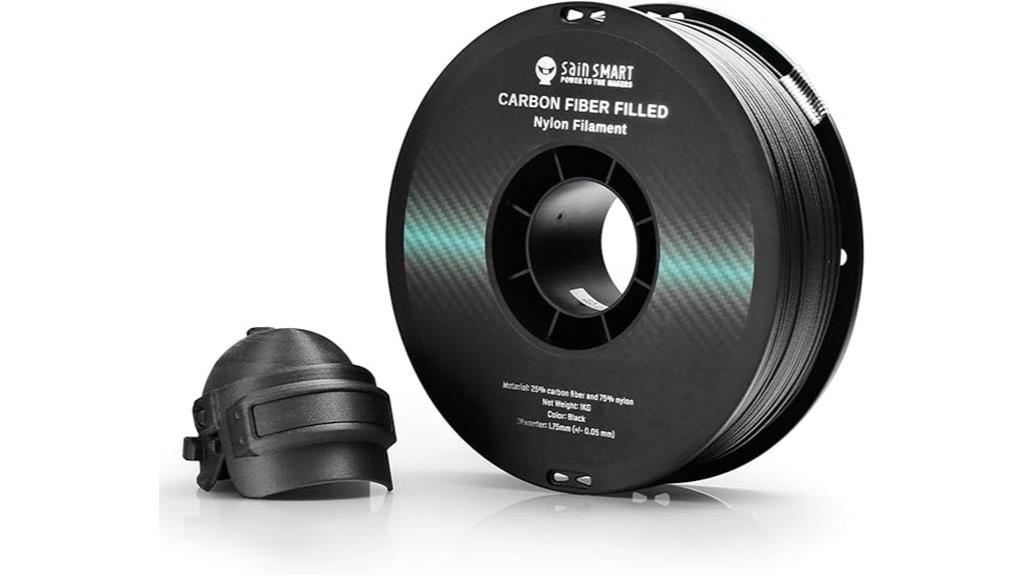
The SainSmart 1.75mm Carbon Fiber Filled Nylon Filament stands out as an excellent choice for professionals and serious hobbyists seeking high-strength, durable 3D printed parts. Made from 80% nylon and 20% carbon fiber, it delivers exceptional rigidity, low shrinkage, and superior surface finish. Its toughness makes it ideal for industrial, medical, and high-stress applications, with excellent layer adhesion and heat resistance. Be aware that its abrasive nature requires hardened steel nozzles, and proper drying is essential for quality prints. Overall, this filament offers a strong, lightweight material that elevates functional and aesthetic projects alike.
Best For: professionals and serious hobbyists requiring high-strength, durable, and precise 3D printed parts for industrial, medical, or high-stress applications.
Pros:
- Exceptional strength, rigidity, and heat resistance for demanding projects
- Excellent layer adhesion and smooth surface finish with minimal post-processing
- Lightweight with a high strength-to-weight ratio, suitable for functional prototypes
Cons:
- Abrasive carbon fiber can wear out nozzles quickly, requiring hardened steel or alloy nozzles
- Requires proper drying and fine-tuning of print settings for optimal results
- Supports and post-processing can be challenging due to layer adhesion and sanding hazards
FLASHFORGE Carbon Fiber PETG Filament 1.75mm, 1KG Spool
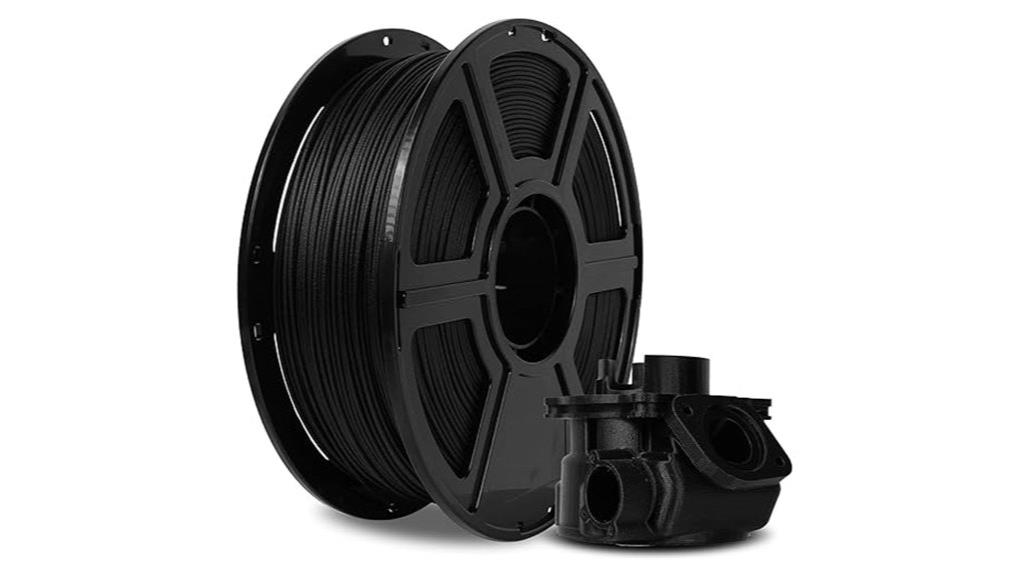
Designed for demanding 3D printing projects, FLASHFORGE’s Carbon Fiber PETG filament offers exceptional strength, rigidity, and surface finish, making it ideal for professionals and enthusiasts seeking high-quality, durable parts. Its carbon fiber reinforcement boosts impact resistance, temperature stability, and dimensional accuracy (+/- 0.02mm), while maintaining PETG’s impact-resistant qualities. The filament is lightweight, moisture-free, and produces a smooth, glossy surface with minimal stringing and warping. Compatible with most FDM printers, it performs well at high speeds (200-220°C) and supports detailed, high-quality finishes suitable for industrial parts, prototypes, and functional applications.
Best For: professionals and enthusiasts seeking high-strength, impact-resistant, and visually striking 3D printed parts for industrial, functional, or aesthetic applications.
Pros:
- Excellent dimensional accuracy (+/- 0.02mm) and surface finish, producing smooth, high-quality layers.
- Strong, rigid, and impact-resistant, suitable for durable prototypes and functional parts.
- Compatible with most FDM 3D printers, performs well at high speeds, and exhibits minimal warping or stringing.
Cons:
- Slightly higher cost compared to standard PETG filaments, though justified by quality.
- Requires precise print settings to minimize stringing and achieve optimal results.
- Some users may experience a learning curve when adjusting to its print performance and finishing techniques.
ELEGOO Carbon Fiber PLA Filament 1.75mm Black 1KG
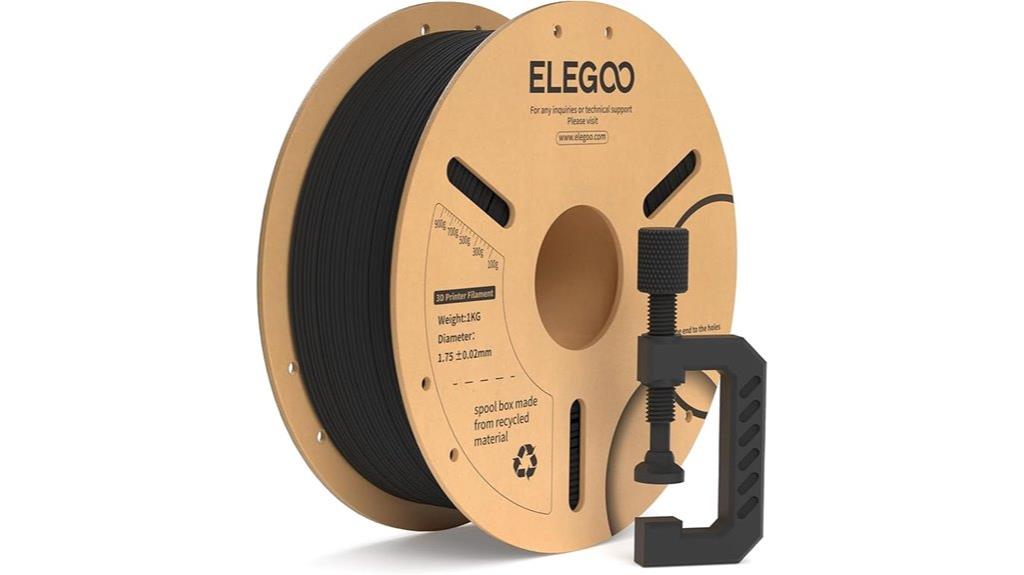
For hobbyists and professionals seeking reliable, high-strength filament, ELEGOO Carbon Fiber PLA 1.75mm Black offers an excellent option. Made with reinforced carbon fiber, it provides exceptional strength, stiffness, and impact resistance, ideal for durable, detailed parts. The filament’s +/- 0.02mm dimensional accuracy guarantees consistent feeding and precise prints. It’s vacuum-sealed and dried to prevent moisture issues like clogging or bubbling. Compatible with most 1.75mm FDM printers and best used with hardened steel nozzles, this filament produces a matte black finish that hides layer lines and looks professional. Users report smooth prints, sharp details, and minimal stringing, making it a versatile choice for high-quality projects.
Best For: hobbyists and professionals seeking high-strength, durable, and precise 3D prints with a professional matte black finish.
Pros:
- High mechanical strength, impact resistance, and stiffness due to reinforced carbon fiber content
- Consistent dimensional accuracy (+/- 0.02mm) for reliable feeding and precise detailing
- Matte black finish minimizes layer line visibility for a professional appearance
Cons:
- Potential issues with filament clogging or moisture absorption affecting print quality
- Inconsistent diameter or thickness variations among different batches or colors
- Some users experience difficulty printing matte black PLA, including filament snapping or hot end clogging
Creality Carbon Fiber 3D Printer Filament (1kg Spool)
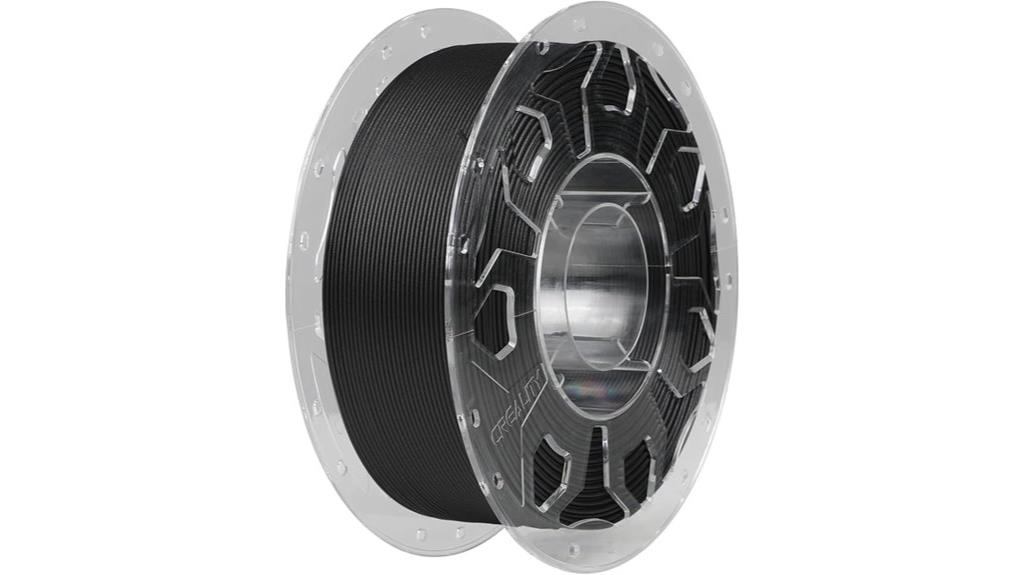
Are you searching for a reliable, high-precision carbon fiber filament compatible with a variety of FDM 3D printers? Creality’s 1kg spool of carbon fiber filament delivers just that. With a 1.75mm diameter and ±0.03mm accuracy, it suits printers like K1C, K1 Max, MK3, Ender series, ELEGOO, and Anycubic. Its excellent weather and chemical resistance, combined with low warping, ensures smooth, detailed prints. The vibrant black color and consistent diameter provide professional results, whether printing miniatures, gears, or decorative objects. Users praise its reliability, minimal stringing, and high-quality finish—though drying beforehand boosts performance. It’s a versatile, eco-friendly choice for demanding projects.
Best For: Hobbyists and professionals seeking high-precision, durable, and aesthetically pleasing carbon fiber filament compatible with a wide range of FDM 3D printers.
Pros:
- Excellent weather and chemical resistance for durable prints
- Consistent 1.75mm diameter with ±0.03mm accuracy ensures smooth, high-quality layers
- Compatible with various popular 3D printers like Ender, MK3, ELEGOO, and Anycubic
Cons:
- Requires filament drying before use to prevent stringing and improve quality
- Slightly higher cost compared to standard filaments due to material properties
- Sensitive to humidity; proper storage and drying are necessary for optimal performance
PRILINE Carbon Fiber Polycarbonate 3D Printer Filament (1kg Spool)
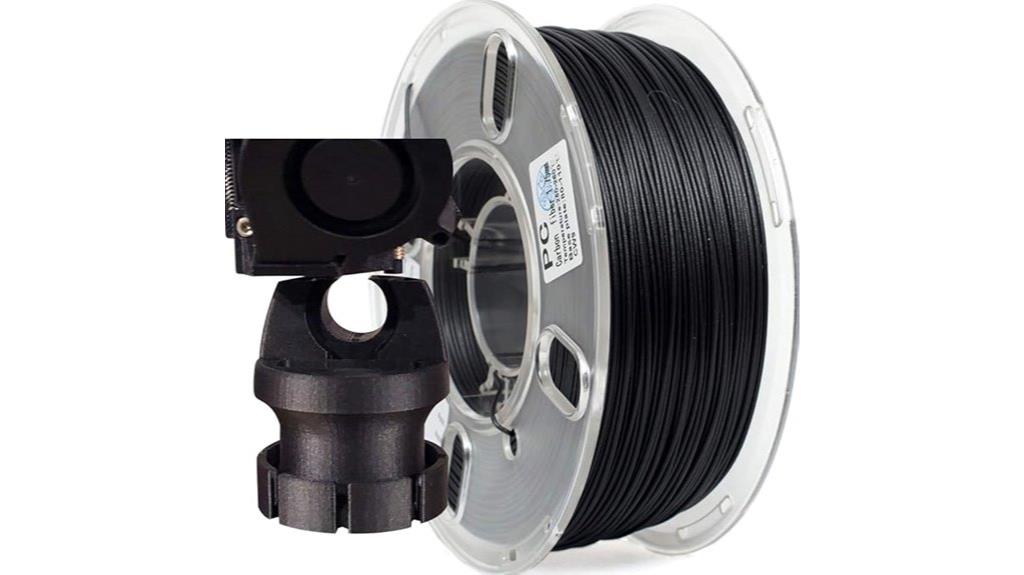
PRILINE Carbon Fiber Polycarbonate 3D Printer Filament (1kg Spool) stands out as an excellent choice for professionals and serious hobbyists seeking high-performance, durable parts. Made from chopped carbon fiber infused polycarbonate or PETG, it offers exceptional strength, stiffness, and toughness. The filament produces matte black, textured finishes that hide layer lines and resist weathering, chemicals, and heat. It’s nearly indestructible, with high temperature resistance and minimal warping. Suitable for engineering-grade parts, it requires specific settings and upgrades like hardened nozzles and high-temp hotends. Despite modest rigidity gains, it’s ideal for creating functional, tough components that can be drilled, tapped, or bent without cracking.
Best For: professionals and serious hobbyists seeking high-strength, durable, and heat-resistant 3D printed parts for engineering and functional applications.
Pros:
- High strength, toughness, and excellent weather and chemical resistance
- Produces matte black textured finishes that hide layer lines and resist warping
- Nearly indestructible with high temperature resistance, suitable for heat-exposed components
Cons:
- Requires specific high-temperature hotends and hardened nozzles for optimal printing
- Demands precise settings and modifications like upgraded heat breaks and build plates
- Printing can be slower and more challenging due to the need for patience and proper drying
Creality 3D Printer Filament PLA Carbon Fiber (Black, 1kg)
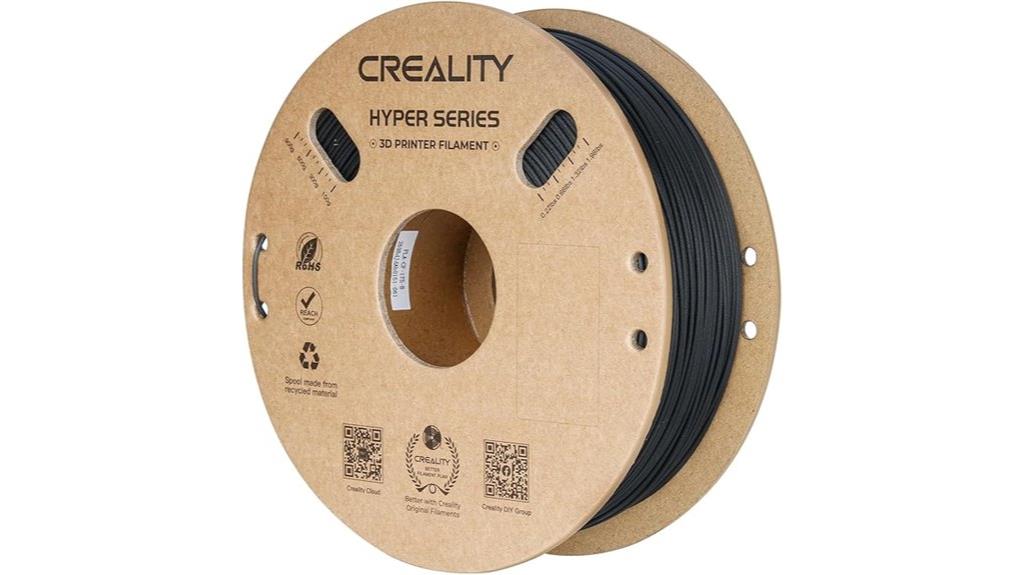
The Creality 3D Printer Filament PLA Carbon Fiber (Black, 1kg) stands out as an excellent choice for those seeking high-strength, precision-engineered filament. Its 1.75mm diameter ensures consistent dimensional accuracy of ±0.03mm, leading to reliable prints. Capable of high-speed printing up to 300mm/s, it produces detailed, delicate models with minimal support removal. With 30% higher mechanical strength than standard PLA, it’s perfect for structural parts like UAVs or aircraft models. Easy to support removal and strong layer bonding reduce failures. Backed by dedicated customer support and a one-year warranty, it’s a dependable filament for demanding applications.
Best For: hobbyists, engineers, and professionals seeking high-strength, precision-engineered filament for demanding 3D printing applications like UAVs, aircraft models, and structural components.
Pros:
- Supports high-speed printing up to 300mm/s with detailed results
- 30% higher mechanical strength than standard PLA for durable parts
- Easy support removal and reliable layer bonding reduce print failures
Cons:
- Slightly more expensive than standard PLA filaments
- Requires precise temperature control to optimize print quality
- May need a hardened nozzle for optimal extrusion of carbon fiber-filled filament
Carbon Fiber PETG Filament 1.75 mm (TINMORRY PETG CF 3D Printer Filament, 1 KG)
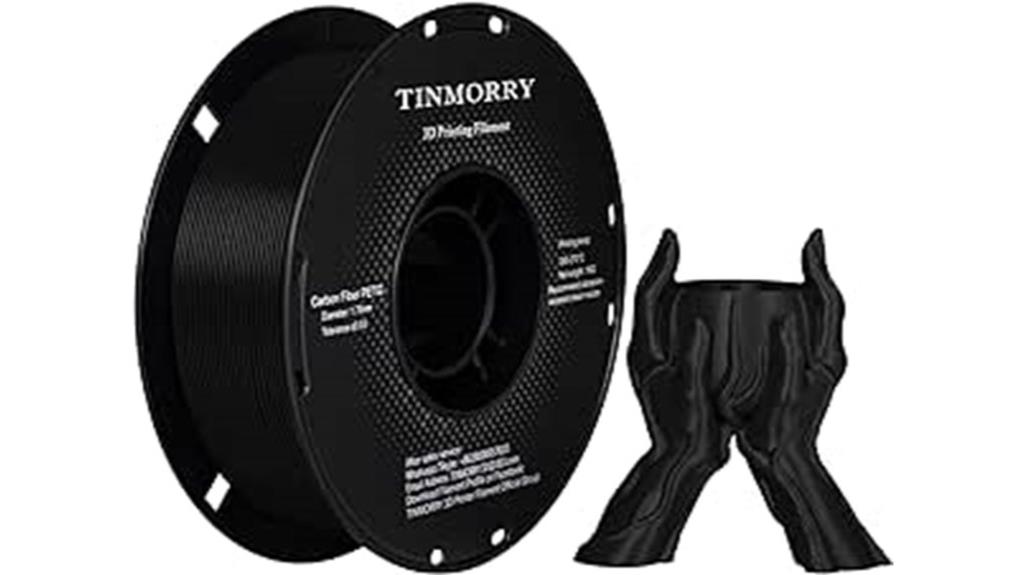
For enthusiasts seeking high-speed, reliable 3D printing with exceptional finish quality, the TINMORRY Carbon Fiber PETG Filament 1.75 mm stands out as an excellent choice. This 1 kg spool is compatible with popular FDM printers like Bambu LAB, Creality, Prusa, VORON, and others. Supporting speeds up to 300 mm/s, it offers faster printing than standard PETG-CF while maintaining high quality. Its proprietary formula contains 15% short-cut carbon fiber, enhancing strength, reducing nozzle wear, and improving Z-adhesion. The matte or shiny finish varies based on settings, producing durable, lightweight parts ideal for functional prototypes, drone components, and racing models.
Best For: hobbyists and professionals seeking high-speed, durable, and high-quality 3D prints with a matte or shiny finish, suitable for functional prototypes, drone parts, and racing models.
Pros:
- Supports high-speed printing up to 300 mm/s with excellent layer adhesion and minimal warping
- Contains 15% short-cut carbon fiber for increased strength, impact resistance, and reduced nozzle wear
- Produces professional, aesthetically pleasing parts with matte or shiny finishes and easy support removal
Cons:
- Abrasive filament requires wear-resistant steel nozzles (≥0.4 mm, preferably 0.6 mm) to prevent nozzle damage
- Carbon fiber dust generated during post-processing (cutting, sanding, grinding) can be harmful; safety precautions needed
- Slight variations in finish (matte or shiny) may occur depending on print settings and resolution
Carbon Fiber PLA Filament (1.75mm, 1kg Spool)
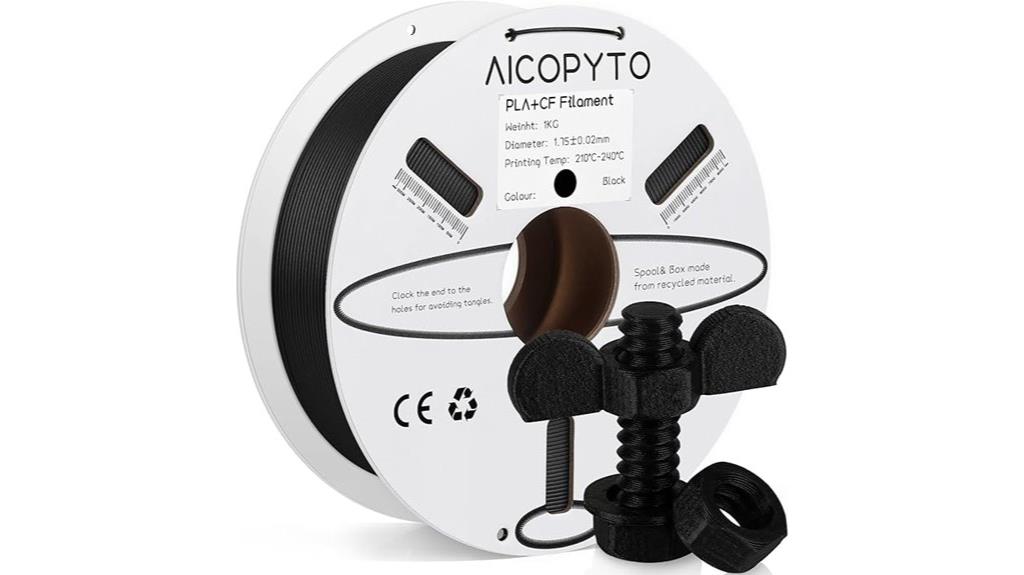
A 1.75mm Carbon Fiber PLA filament on a 1kg spool stands out as an excellent choice for those seeking high-stiffness, heat-resistant parts with a professional matte finish. Its premium carbon fiber content delivers excellent structural strength and rigidity, ideal for functional and aesthetic projects. The filament boasts smooth extrusion, strong layer adhesion, and resists warping, jamming, and delamination. Vacuum-sealed and dried, it guarantees clog-free printing and consistent results. With precise dimensional accuracy and recommended settings of 210–230°C nozzle temperature, it’s easy to use. Overall, this filament offers a reliable, high-quality option for creating detailed, impact-resistant, and visually appealing parts.
Best For: hobbyists and professionals seeking high-stiffness, heat-resistant 3D printed parts with a professional matte finish and precise detail.
Pros:
- Excellent structural strength and rigidity due to premium carbon fiber content
- Smooth extrusion with minimal warping, jamming, or delamination
- Consistent diameter and precise color, especially true black, for high-quality prints
Cons:
- Can be brittle and may require careful handling during printing and post-processing
- Slightly more challenging to extrude for beginners compared to standard PLA
- Higher cost compared to regular PLA filaments
MakerBot Nylon 12 Carbon Fiber Filament Spool (2-Pack)
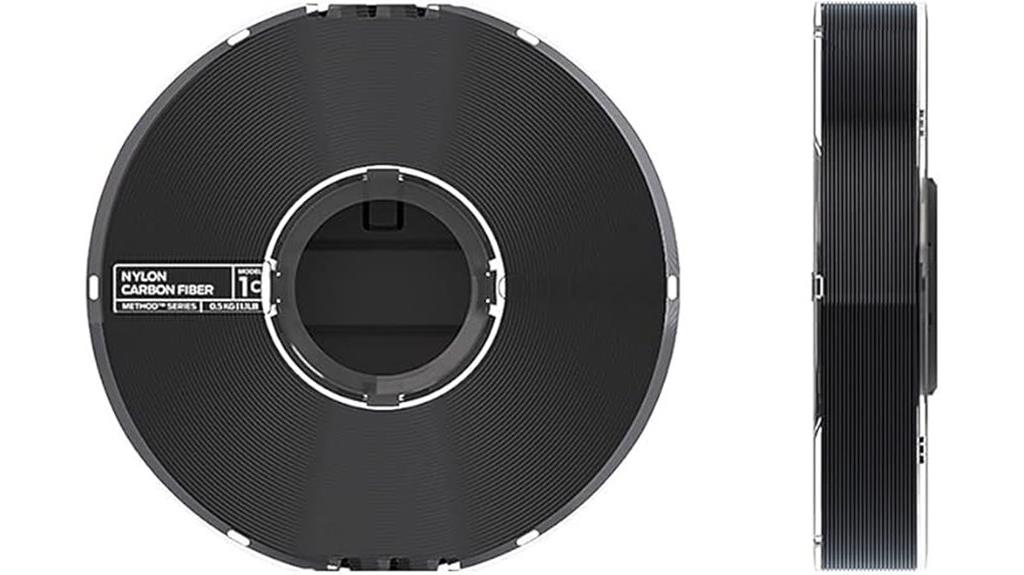
Anyone seeking high-performance filament compatible with MakerBot’s Method and Method X 3D printers should contemplate the MakerBot Nylon 12 Carbon Fiber Spool (2-Pack). This 1.1-pound spool offers durability, moisture resistance, and high stiffness, making it perfect for functional, precise parts like automotive brackets or inspection gauges. The carbon fiber reinforcement boosts strength without sacrificing ease of use, thanks to the smart RFID-enabled spool that tracks material info. Its high heat deflection temperature of 154°C and tensile strength of 66 MPa ensure reliable, detailed results. Stored properly in vacuum-sealed packaging with desiccant, this bundle provides a versatile, robust solution for demanding applications.
Best For: professionals and hobbyists seeking durable, high-stiffness nylon filament with carbon fiber reinforcement compatible with MakerBot Method and Method X 3D printers for precise, functional parts.
Pros:
- High stiffness with a tensile modulus of 6000 MPa, ideal for load-bearing applications.
- Excellent moisture resistance and consistent print quality thanks to integrated desiccants and RFID tracking.
- Suitable for complex, high-precision parts like automotive brackets and inspection gauges.
Cons:
- Slightly more brittle than standard nylon, requiring careful handling during printing.
- Storage demands attention—must be kept in vacuum-sealed bags with desiccant to prevent moisture absorption.
- Higher cost compared to generic nylon filaments, reflecting its specialized composition and reinforced properties.
Creality 3D Printer Filament PLA Carbon Fiber (Black)
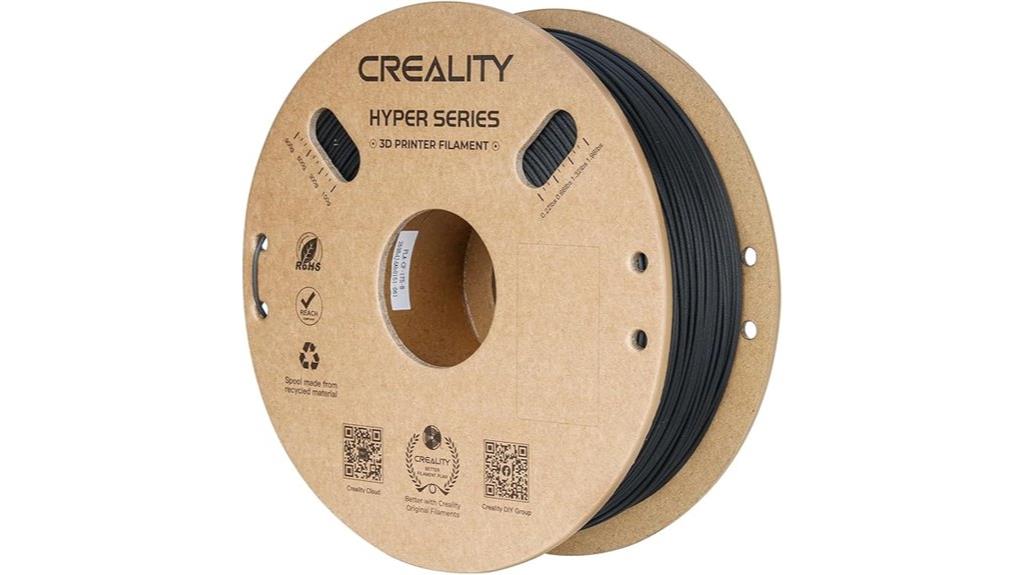
The Creality 3D Printer Filament PLA Carbon Fiber (Black) stands out for those seeking high-strength, precision prints at high speeds. This 1.75mm filament, compatible with K1C and most third-party printers, boasts a consistent ±0.03mm dimensional accuracy and a 1kg spool. It supports speeds up to 300mm/s, maintaining detail and reducing print time. Its enhanced mechanical properties—30% stronger than standard PLA—make it ideal for structural parts in demanding environments like UAVs or aircraft models. Designed for easy support removal and reliable layer bonding, it ensures quality finishes. Backed by expert support, it’s a reliable choice for high-performance, durable prints.
Best For: hobbyists and professionals seeking high-strength, precise, and fast 3D prints for structural and demanding applications like UAVs and aircraft models.
Pros:
- Supports high-speed printing up to 300mm/s without losing detail
- 30% higher mechanical strength than standard PLA, ideal for durable parts
- Easy support removal and reliable layer bonding for smooth finishes
Cons:
- Slightly more expensive than standard PLA filaments
- Requires careful calibration to achieve optimal results due to its high-performance properties
- Potential for increased nozzle wear with abrasive fibers if not properly maintained
Creality Hyper PLA-CF Carbon Fiber 3D Printer Filament (1kg/Spool)
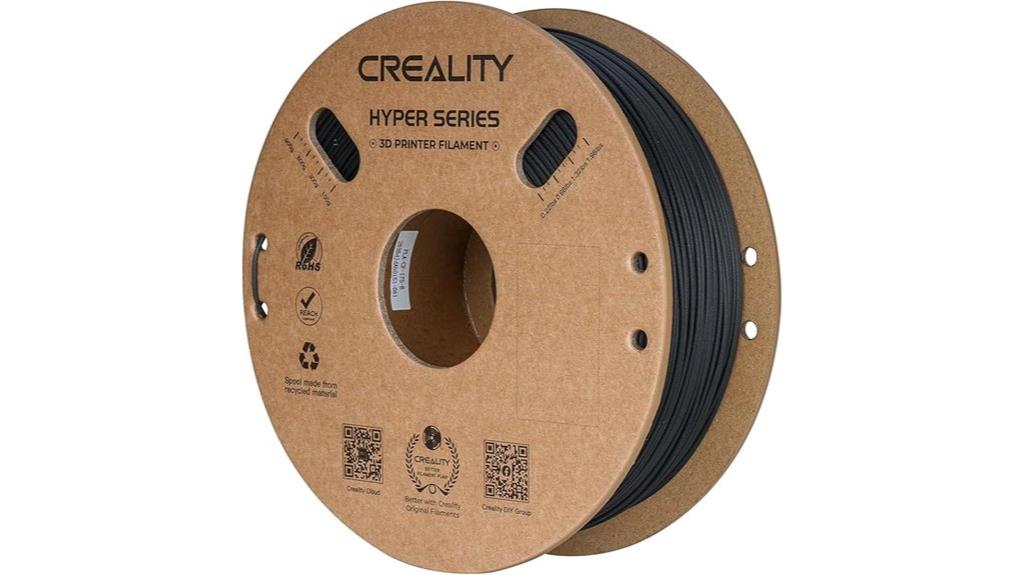
Creality Hyper PLA-CF Carbon Fiber 3D Printer Filament (1kg/Spool) stands out as an excellent choice for professionals and hobbyists seeking high-strength, lightweight parts. It supports high-speed printing up to 300mm/s while maintaining great surface quality. Compatible with most 1.75mm printers, it’s easy to use and offers precise dimensional accuracy of ±0.03mm. Its carbon fiber reinforcement boosts flexural strength and impact resistance by up to 30%, making it perfect for durable, demanding applications like drone parts and UAV frames. Users praise its reliability, vibrant aesthetics, and minimal post-processing needs, making it a versatile solution for high-performance, visually appealing prints.
Best For: hobbyists and professionals seeking high-strength, lightweight, and visually appealing 3D printed parts for demanding applications like drones and UAVs.
Pros:
- Supports high-speed printing up to 300mm/s with excellent surface quality
- Up to 30% higher flexural strength and impact resistance due to carbon fiber reinforcement
- Compatible with most 1.75mm 3D printers and easy to use with minimal post-processing
Cons:
- Slightly higher price compared to standard PLA filaments
- Requires precise temperature settings for optimal adhesion and quality
- Potential for initial clogs or top layer issues, which may need troubleshooting
VOXELAB Carbon Fiber PETG 3D Printer Filament (1kg)
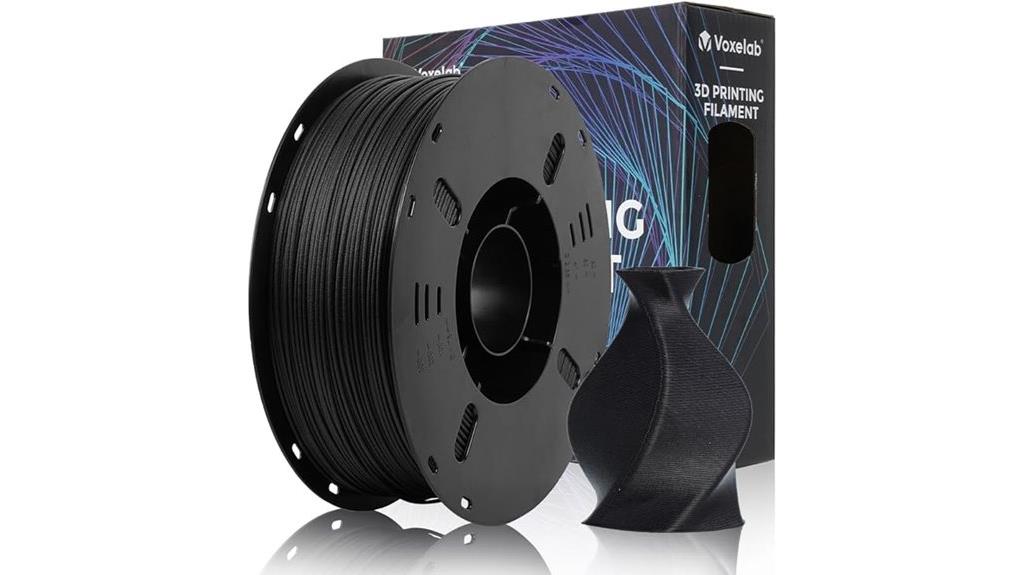
If you’re seeking a high-performance filament that combines strength, precision, and a sleek finish, VOXELAB Carbon Fiber PETG 3D Printer Filament (1kg) is an excellent choice. This composite blends PETG with carbon fibers, boosting rigidity, durability, and heat resistance. It produces parts with a textured, professional surface that hides layer lines, ideal for both aesthetic and functional applications. Despite its abrasiveness, it offers smooth extrusion on most printers with proper calibration and a hardened nozzle. Lightweight yet stronger than standard PETG, it’s perfect for structural projects in aerospace, automotive, or industrial settings. Many users appreciate its reliability, high quality, and excellent dimensional stability.
Best For: hobbyists and professionals seeking high-strength, aesthetically refined 3D printed parts for aerospace, automotive, or industrial applications.
Pros:
- Excellent dimensional stability and high heat/chemical resistance
- Produces a textured, professional surface finish that conceals layer lines
- Lightweight yet significantly stronger than standard PETG, ideal for structural components
Cons:
- Abrasive nature requires a hardened, larger nozzle (0.6mm or bigger) and frequent maintenance
- Proper filament drying (around 6 hours) is essential for optimal print quality
- Slightly higher cost compared to standard PETG, with potential hotend wear if not properly managed
VOXELAB Carbon Fiber PLA 3D Printer Filament
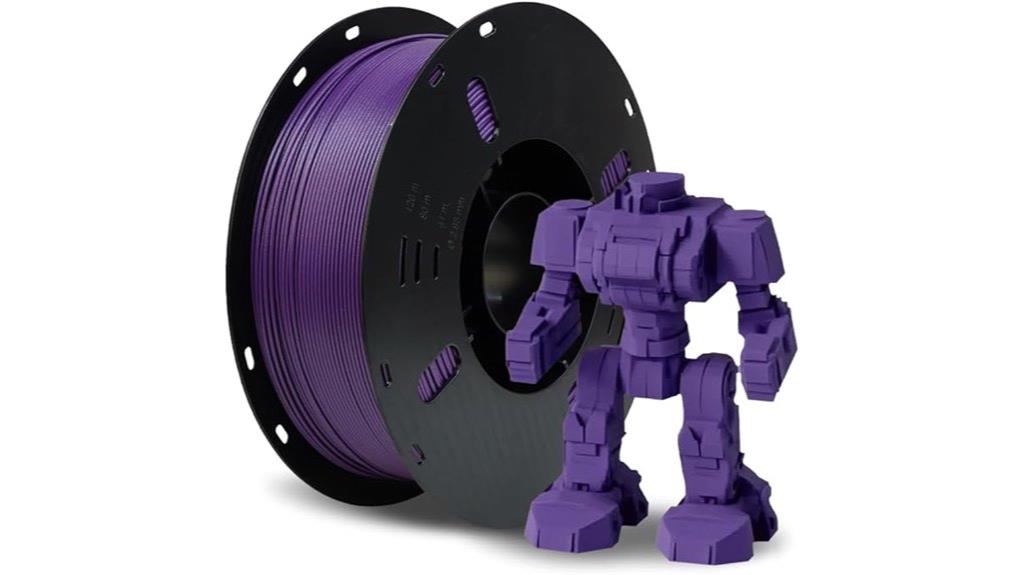
For those seeking a filament that offers both strength and an attractive textured finish, VOXELAB Carbon Fiber PLA stands out as an excellent choice. It combines PLA with carbon fiber reinforcement, resulting in stronger, lightweight, and durable parts ideal for weight-sensitive projects. The 1.75mm filament in Iris Purple produces a professional, textured surface and boasts high stiffness for precise, accurate prints. Its reduced warping and shrinkage ensure reliability across various printers, while its superior chemical and heat resistance make it perfect for functional applications. Plus, its dimensional accuracy of +/- 0.02mm guarantees detailed, high-quality results every time.
Best For: hobbyists and professionals seeking high-strength, lightweight, and aesthetically textured 3D prints for functional or weight-sensitive applications.
Pros:
- Enhanced strength, stiffness, and durability due to carbon fiber reinforcement
- Reduced warping and shrinkage for reliable, precise printing
- Superior surface finish with textured, professional appearance
Cons:
- Slightly more abrasive, which may cause wear on nozzles over time
- Requires careful handling to prevent inhalation of fine fibers during printing
- May need optimized print settings to achieve best results with certain printers
SUNLU Carbon Fiber PETG Filament for 3D Printing

SUNLU Carbon Fiber PETG Filament stands out for those seeking a durable, high-strength material with a sleek matte finish. Its 1.75mm diameter and 1kg spool make it compatible with most FDM printers, reinforced with 10% carbon fiber for added impact resistance and strength. The filament’s frosted matte texture provides a sophisticated look, ideal for aesthetic projects. It offers excellent layer adhesion, minimal stringing, and high heat resistance up to 130°C. Although it takes about 30% longer to print than PLA, the resulting parts are stronger, weather-resistant, and more refined. Users praise its consistent quality, though spool design can sometimes cause feeding issues.
Best For: hobbyists and professionals seeking a high-strength, aesthetically refined filament for durable, impact-resistant 3D printed parts.
Pros:
- Excellent impact strength and weather resistance for outdoor and functional parts
- Strong layer adhesion with minimal stringing, resulting in smooth, detailed finishes
- Matte black, frosted texture offers a sophisticated aesthetic suitable for high-end projects
Cons:
- Slightly longer print times (~30% more than PLA) may affect productivity
- Filament spool design can cause feeding issues, especially with multi-color or multi-printer setups
- Can be dusty or tangled upon opening, requiring proper storage and handling
Factors to Consider When Choosing Carbon‑Fiber Filament Spools
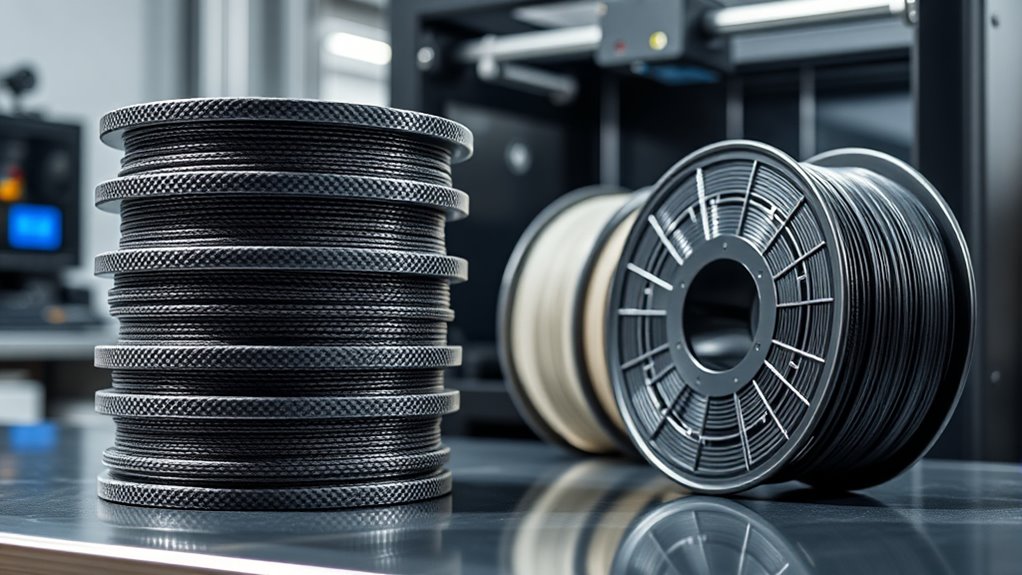
When selecting a carbon-fiber filament spool, I look at material compatibility and how it matches my printer’s settings to guarantee ideal results. I also consider the risk of nozzle wear and the quality of the surface finish I can expect. Finally, I pay attention to moisture sensitivity and proper storage to keep the filament in top condition.
Material Compatibility
Choosing the right carbon-fiber filament spool starts with guaranteeing material compatibility with your 3D printer. First, check that the filament’s temperature range fits your hotend, typically between 240°C and 270°C for carbon fiber. Next, verify your nozzle material; abrasive filaments like carbon fiber require hardened steel or stainless steel nozzles to prevent wear. Also, confirm the filament diameter, usually 1.75mm, matches your printer’s specifications for smooth feeding and extrusion. Consider the filament’s chemical resistance and environmental durability, especially if you plan to use it outdoors or in high-temperature settings. Ultimately, confirm the filament is compatible with your print bed surface and adhesion methods to avoid warping or layer separation. Proper compatibility ensures quality prints and reduces equipment issues.
Print Settings Optimization
Optimizing print settings is key to getting the best results from your carbon-fiber filament spools. I recommend setting the extrusion temperature toward the higher end of the recommended range, around 240-270°C, to ensure the abrasive fibers melt properly. Use hardened steel nozzles or other wear-resistant options, as carbon fiber’s abrasiveness can accelerate nozzle wear and impact quality. Fine-tune your print speeds, often reducing them to 30-40mm/sec, to improve layer adhesion and surface finish. Proper bed adhesion techniques, like textured surfaces or glue sticks, help prevent warping and enhance dimensional accuracy. Ultimately, dry your filament at around 65°C for 4-8 hours to avoid moisture-related issues like bubbling, stringing, and layer inconsistencies.
Nozzle Wear Risks
Since carbon-fiber reinforced filaments are highly abrasive, selecting the right nozzle material is vital to prevent rapid wear and maintain print quality. Softer metals like brass wear out quickly when used with these filaments, leading to clogging and inconsistent extrusion. To avoid this, I recommend using hardened steel or tungsten carbide nozzles, which resist wear and guarantee longevity. The abrasive particles can also cause nozzle clogging if hotend components aren’t compatible or well-maintained. Regular inspection and timely replacement of nozzles are essential to keep prints consistent and avoid damage. Additionally, proper filament drying and ideal temperatures help reduce wear by maintaining smooth flow and minimizing clogging. Choosing the right nozzle material and maintaining your hotend are key steps in managing nozzle wear risks.
Surface Finish Quality
The surface finish of a carbon-fiber filament plays a significant role in the final look and feel of your print. Typically, it has a matte and textured surface that helps hide layer lines and imperfections, giving a more professional appearance. High-quality filaments produce smooth, consistent layers with minimal stringing, resulting in a polished surface. Achieving the best finish also depends on proper print settings like temperature and speed, which influence smoothness and gloss. The filament’s formulation can create a finish resembling a mold-made, high-end look, either matte or with a subtle shimmer. While post-processing—sanding or coating—can further improve surface quality, it’s essential to handle these methods carefully to avoid hazardous dust.
Moisture and Storage
Moisture absorption is a critical concern when choosing carbon-fiber filament spools because even small amounts of humidity can cause print defects. Since these filaments are highly hygroscopic, they quickly absorb moisture from the air, leading to bubbling, stringing, and poor layer adhesion. Proper storage is essential; I recommend sealing spools in airtight containers with desiccants to keep humidity low. Before printing, it’s crucial to dry the filament at 60–80°C for several hours to remove absorbed moisture. Maintaining a dry environment ensures consistent extrusion, reduces nozzle clogs, and results in smoother, higher-quality prints. Regularly checking and drying your filament helps achieve peak performance and durability, making moisture control a key factor in successful 3D printing with carbon fiber.
Strength and Flexibility
Choosing the right carbon-fiber filament involves understanding the trade-off between strength and flexibility. Carbon-fiber reinforced filaments boost tensile strength and stiffness, making parts more durable and impact-resistant. However, increased rigidity often means less flexibility, resulting in brittle prints that can crack under stress. The percentage of carbon fiber in the filament determines this balance—more fiber usually means a stronger but less flexible part. Some formulations are engineered to retain a degree of bendability, allowing for functional components that need both strength and some flexibility. Knowing this balance is essential because it guides you toward the right filament for your project—whether you need rigid structural parts or flexible prototypes. This understanding helps you choose a filament that best matches your specific application.
Price and Value
Since cost is a major factor when selecting carbon-fiber filaments, it’s important to weigh the price against the value they offer. Prices typically range from $20 to over $50 per kilogram, so budget considerations are vital, especially for large or multiple projects. Higher-priced options often deliver better consistency, fewer print issues, and smoother finishes, which can justify the initial investment. The durability and mechanical strength improvements from premium filaments make them worthwhile for high-performance parts that need longevity. Additionally, features like vacuum-sealed packaging and thorough drying help prevent costly failures and material waste. Comparing different brands and qualities based on price-to-performance ratios ensures you get the best value, balancing cost with the performance needed for your specific application.
Frequently Asked Questions
How Does Filament Storage Affect Carbon-Fiber Filament Quality?
When it comes to filament storage, I’ve learned it’s vital for maintaining carbon-fiber filament quality. If I don’t keep it sealed and dry, moisture can get in, leading to poor print strength and surface finish. I always store my spools in airtight containers with desiccants. Proper storage prevents clogs, weak spots, and guarantees my prints remain strong and consistent. Good storage really makes a difference in the final result.
Can Existing 3D Printers Handle New Carbon-Fiber Filament Types?
You’re wondering if your current 3D printer can handle new carbon-fiber filaments. I’d say it depends on your printer’s capabilities. Most modern printers with a hardened steel or ruby nozzle can handle these abrasives, but check your machine’s specifications. You might also need to raise the nozzle temperature and ensure it has a robust extrusion system. Upgrading certain parts can make printing with carbon fiber smoother and more successful.
Are There Environmental Impacts With Different Carbon-Fiber Filament Spools?
Let’s talk about the toll of different filament spools. I’ve found that some carbon-fiber spools, especially those with biodegradable or recyclable materials, reduce environmental impact. But, unfortunately, traditional spools often contribute to plastic waste. I recommend choosing eco-friendly options to minimize my carbon footprint while still creating strong, stunning prints. Being mindful of spool materials helps me print proudly, knowing I’m helping protect our planet.
How Do Color Options Influence Filament Strength and Finish?
Color options can influence filament strength and finish more than you might think. I’ve found that darker colors, like black or navy, often have slightly better UV resistance and smoother finishes, while vibrant hues might show layer lines more clearly. The pigments used can also affect the filament’s overall properties, so I recommend choosing colors based on your project’s durability needs and desired aesthetics for the best results.
What Post-Processing Techniques Optimize Carbon-Fiber Print Durability?
Imagine your prints as a sculpture waiting to be perfected. To boost durability, I recommend annealing your carbon-fiber prints—gently heating them to relieve internal stresses. Sanding rough surfaces and applying a protective epoxy coat also help reinforce strength and improve finish. These techniques act like armor, transforming your printed parts into resilient, long-lasting masterpieces that stand up to daily wear and tear.
Conclusion
So, there you have it—your ultimate lineup of carbon-fiber filament spools for 2025. Whether you’re chasing strength, style, or just bragging rights at the 3D printing club, these options are your new best friends. Just remember, with great filament comes great responsibility—and maybe a few broken nozzles. Happy printing, and may your prints be as flawless as your Instagram feed. Now go conquer that printer like the filament warrior you were born to be!



